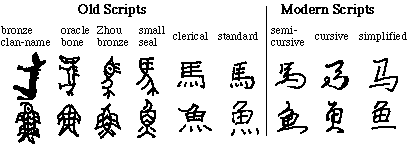
A large set of Chinese characters used in text appeared about 3400 years ago in the late Shang dynasty. Since then, Chinese characters have been used continuously, albeit changing their script styles. The changes have been brought about partly by the uses to which characters are put, and partly by the kinds of writing materials availablebone, bronze, bamboo, wood, stone, silk, and paperas well as by writing implements such as chisel, knife, brush, and pen. By and large, the shapes of characters have been simplified and stylized for convenience of writing. Of the several script styles, Table 3-1 (partly based on Qiu 1988: 28) shows eight that are important for our discussion: clan-name bronze, oracle bone, Zhou bronze, small seal, clerical, standard, semi-cursive, and cursive.
...
Table 3-1. Evolution of Script Styles of Chinese Characters

The popular form during the Shang dynasty was the oracle-bone script
(jiaguwen), whose characters were incised with a knife on hard bones
and shells. ![]()
Oracle-bone characters were either regular or irregular in size and shape, and were arranged either neatly or higgledy-piggledy on bones and shells. Some characters were written in mirror reversals. They were written vertically, a column of text moving usually from right to left (which became the traditional writing direction), but sometimes left to right. They became more regular in shape and arrangement in a few hundred years of use.
When Qin unified the warring states in the 3rd century BC, its first emperor standardized the varied shapes of characters that were used there. He had his minister standardize them as a small-seal script (xiaozhuan), by simplifying the traditional Qin script, i.e., the great-seal script, and suppressing variant forms used in other states. ... (This first emperor also standardized coins, weights, measurements, and enlarged the Great Wall, which was further enlarged during the Ming dynasty and still stands today.)
Thanks to the Qin emperor's standardization, Chinese characters have since been seen as a glue that unifies the various Chinese peoples who speak diverse "dialects." The Qin emperor was the first ruler who could read, and started the tradition that learning to read should be part of the emperor's training. The small-seal script represents the last stage of old Chinese writing. Today it is used only on seals or chop signs used as signatures by Chinese, Japanese, and Koreans.
Some simplified seal characters of the late Warring States evolved into
a clerical script (lishu). The clerical script, so called because
it was used by official clerks, was the popular form in the Qin period,
whose orthodox form was the small-seal script. ![]() The clerical script is used today
as an art form in calligraphy.
The clerical script is used today
as an art form in calligraphy.
The clerical script began to change into the standard script (kaishu) during the latter part of the Han dynasty, and in that form became dominant with the advent of printing technology in the late Tang (618907) and early Song (9601279) dynasties.
(Here's a link to a site with some more examples of the transition between oracle bone and modern characters)